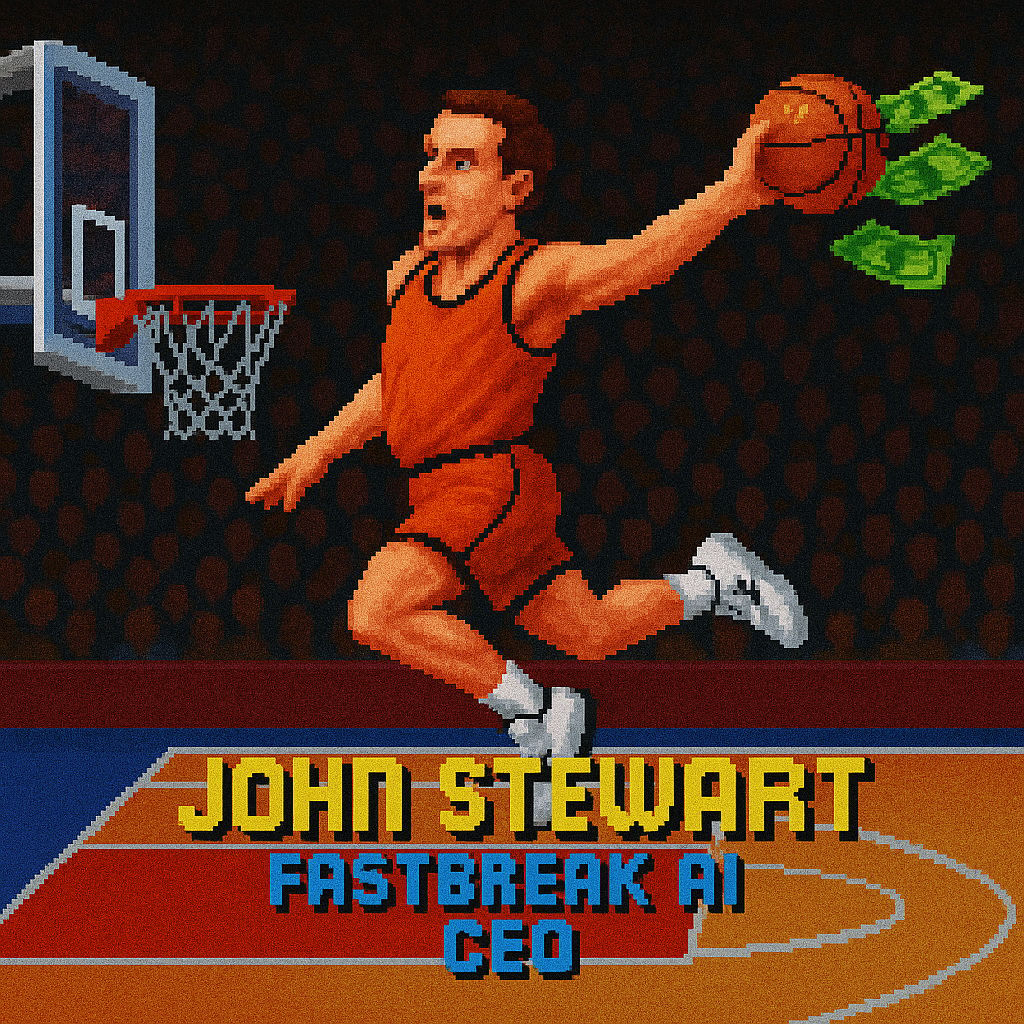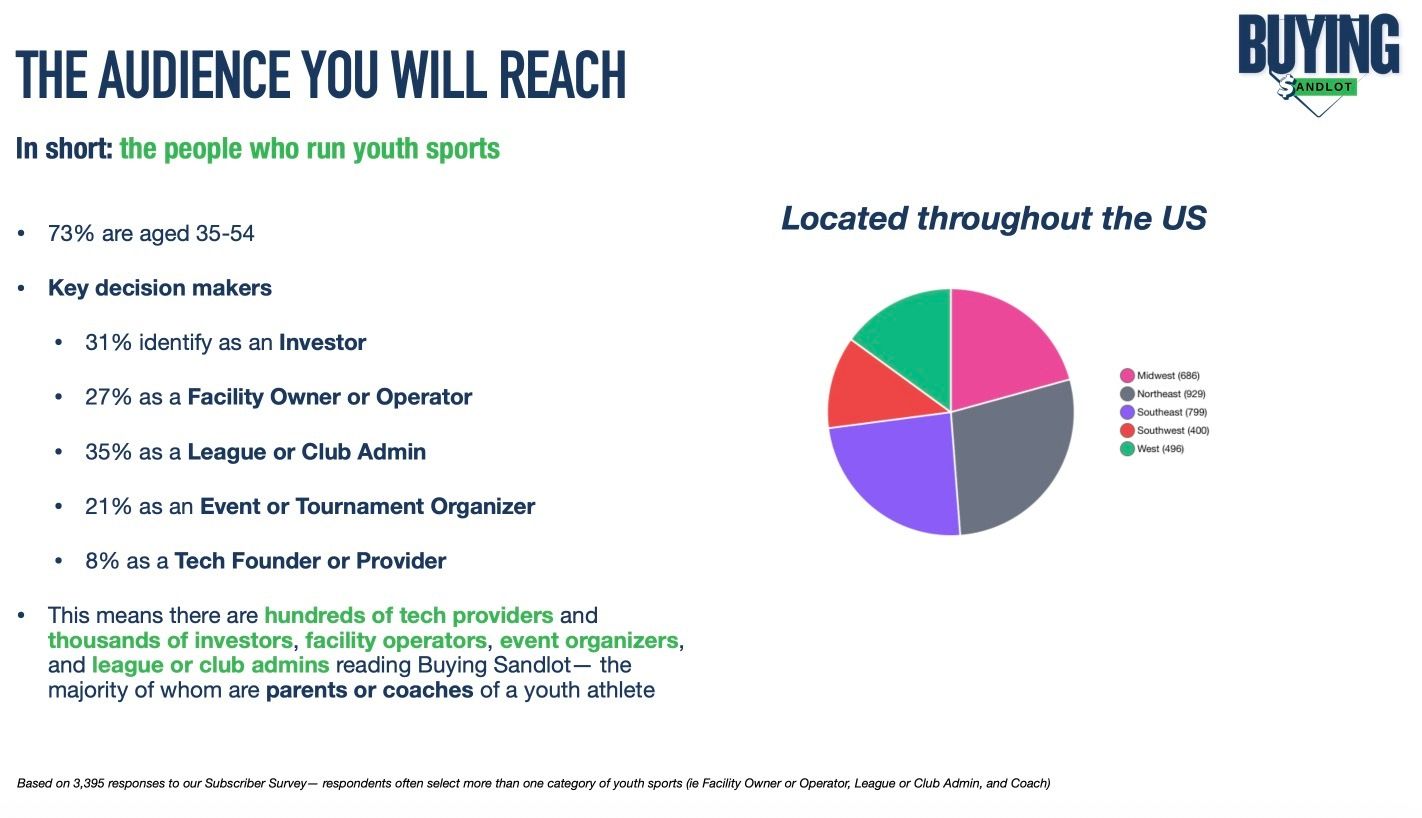
This is Buying Sandlot — the only newsletter that focuses solely on the business of youth sports.
Get that bag, folks.
Let’s get to it.
In the email today:
🤖 Fastbreak AI’s Star-Studded Investment Round

The Charlotte-based sports operations software company has secured $40M in Series A funding.
The new investment will be directed toward expansion in the youth sports market and the growth of Fastbreak Compete, an all-in-one platform for amateur sports operators.
“We’ve shown what’s possible by setting a new standard of innovation in professional sports, and now we’re bringing that same momentum to amateur sports,” Fastbreak AI CEO John Stewart said. “This funding fuels our work across both levels of the game, accelerating innovation in pro sports while building the connected infrastructure youth sports has long needed. Our focus is on eliminating time spent on logistics to empower sports organizations to create amazing experiences for players, fans and families.”
Fastbreak builds schedules for the MLS, NBA, NHL, Serie A — Italy’s top-flight soccer league — and over 50 other leagues worldwide. It has also begun working with youth sports governing bodies and organizations.
Fastbreak Compete creates schedules, but also manages communications, registration, team travel, ticketing and on-site event operations.
John will be an upcoming guest on our podcast - we recorded it a couple of weeks ago - and these clips should give you an idea of HOW BIG he is thinking:
A roster of the glossy — and diversified names connected to the raise:
Firms: Greycroft and GTMfund
Leagues: NBA, NHL and TMRW Sports
Pro athletes: Patrick Cantlay, Larry Fitzgerald Jr., Kurt Kitayama and Luke Kuechly
This is a MASSIVE fundraising round. In terms of Series A in youth sports that we can find, it trails only Hudl’s $72.5 million round in 2015.
Here’s are quick highlights of larger rounds (not Series A):
LOVB (League One Volleyball) $100M (Nov 2024) to scale its club-to-pro model.
Unrivaled Sports $120M (May 2025) across youth facilities/events.
Snap! Mobile (Snap Raise) $90M (2021) in high-school activities fintech.
Veo $80M Series C (2022), AI video cameras used widely in youth.
Pixellot $161M Series D (2022), automated youth/HS streaming.
Big time stuff.

I’m just gonna be honest here— I’ve talked to many people in the space, but John is the one who left me thinking: That guy’s gonna be a billionaire.
He’s done this before— sold his last company, MapAnything, to SalesForce for $250 million.
Maybe I’m wrong. There are lots of practical reasons why accomplishing the dominant market position Fastbreak thinks it can get will be difficult or downright impossible. But there is sort of a speed and force with which they seem to be running that really jumps out… almost like a fastbreak.*
*Thanks, I’m here all week. Be sure to tip your waiters buy an ad.
💸 New Buying Sandlot Ad Packages Now Available

There are limited sponsorship opportunities remaining for Q4 and even Q1 to put your company in front of more than 12,000 youth sports owners, operators and investors.
That includes the c-suite of virtually every single major company in this space.
To simplify things (and make poor sales guy Paul’s life easier), we’re publishing the rates directly in the newsletter:
Newsletter Sponsorship (literally this section): $1,500
5-Day Package: $6,000
15-Day Package: $15,000
Podcast Sponsorship (1 show): $500
Monthly Podcast Sponsorship (8 shows): $4,000
For ad spends beyond $25k, we can work with you on a custom package. We will almost certainly be raising these rates at the start of the year, so act accordingly.
Newsletter sponsorships get you 1) logo in the header and 2) a custom content section (right here) about your business, product or service.
We’re opening up podcast sponsorships that include a host-read ad before and after the guest, along with logo inclusion in all video and social clips from the show.
In short, there is not a way to reach a larger concentration of youth sports professionals than with a single Buying Sandlot email.
If you’re interested in advertising, contact [email protected]
🚨 More Heat On The Dallas Stars
The NHL team is a focus in an ongoing Texas Attorney General antitrust probe regarding the youth hockey industry, according to USA Today.
ICYMI: The media outlet published an investigative report in August — full breakdown here — on the Stars’ control of youth hockey, and alleged abuse of it, in a large swath of the state. And that report was a follow-up from a March report on former team employees accused of enriching themselves through stay-to-play policies for Stars-run tournaments.
The August report included an interview with an attorney who said the Stars’ stranglehold on ice space in the Dallas area could constitute illegal anticompetitive business practices.
The Stars control 10 rinks in the region, according to USA Today — three by direct ownership and the others through long-term lease deals where cities build the facilities and the Stars pay back the investment over time while keeping profits.
The investigation is said to be in the early stages; the Stars said they have not been contacted by the AG.
👷♂️ Recapping SFC Webinar On Sports Projects
I (James) listened in on a Sports Facilities Companies webinar discussing all facets of major sports and entertainment venue projects
A few interesting notes I gleaned:
1) The term “public-private partnership” (or P3) can be nebulous. Eric Sullivan, a partner at SFC, did a great job of demystifying it.
“Almost everything is a P3 in some way, shape or form because there are so many efficiencies to gain. It just makes a lot of sense,” he said, adding P3s are at their core “a delivery model” — the public and private sectors worked together to identify efficiencies and capitalize and develop bigger, better destinations.
Land availability and zoning assistance
Economic tools — tax incentives, grants, etc. — that provide capital at lower costs than the private market
Support from tourism officials, parks and recreation and other public programs
Cities experience development and see direct spending and tax creation
“A public-private partnership should really be a triple win,” Sullivan said. “The public sector should win because they get a better project delivered more efficiently than they could do on their own. The private sector should win because they get better cost of capital and more efficient, bigger and better projects. And ultimately if the public and private sectors win from a development standpoint, the community is going to win because they are going to have a better project at the end of the day.”
2) Sullivan said many colleges are encouraging P3 mixed-use developments on campuses around sports venues to generate new revenue streams in the NIL era. Here is an example at Wake Forest.
3) Zoning can be a big hurdle for many projects — i.e. using vacant retail space for unrelated development. But projects can also lean into the existing zoning and repurpose/better use spaces like tired parks, antiquated municipal golf courses and fairgrounds that sit dormant most of the year.
4) Kosmont Companies president Ken Hira said that open space and public space have become the “anchor tenant” for major projects.
“The sports world can have a lot to do with that by activating these green spaces that can really drive something that is experiential. That’s what the consumer wants, is experience.”
So many of these projects seem to be built around venues — arenas, stadiums, indoor facilities — that can be used year-round. But green space seems — at least at first glance — to be potentially simpler to pull off and more conducive to youth sports.
5) Hira and Sullivan agreed the biggest hurdle to these projects is often paying for them. And there is no “silver bullet,” Hira said — getting back to the P3 trend and the various tools it provides.
🏈 Marquee HS Football Showdown Gets Scrapped
The nation’s top teams will not play this year after a tumultuous week.
No. 1 St. Frances of Baltimore was set to play No. 2 IMG Academy tonight in Bradenton
IMG announced on Wednesday the game would not be played as scheduled
St. Frances told The Baltimore Sun yesterday the game would be pushed back to Dec. 10 to accommodate a national television broadcast
IMG now says it will not participate, citing health and safety concerns due to a six-week layoff and the college transition for its seniors

We talk about fragmentation a lot here. This is a great example.
IMG and St. Frances are not tethered to state-based governing bodies and play independent schedules that offer flexibility.
Maybe too much in this situation, because now a game that would have been played as the season finale for both teams is not going to happen.
This incident makes a pretty good argument for some sort of elite high school super-league, if for no other reason than to ensure these on-the-fly moves don’t happen in the future.
It also speaks to where high school sports stands as a media property. Even a much-ballyhooed matchup like this had peak value to an unnamed broadcast partner if they could put it on a Wednesday night during a slow part of the sports calendar.
🦓 Youth Sports Officiating News
The Georgia Recreation and Park Association will roll out virtual officiating courses next year.
The goal is to make becoming an official more accessible and recruit new candidates to address ongoing shortages; the program would be designed to let participants start as youth sports officials and work their way up to high school events.
The Atlanta Braves, Atlanta Falcons and Atlanta United are partners in the initiative.
Elsewhere:
The Kansas City Chiefs will offer free training for girls flag football officials in parts of Kansas and Missouri in conjunction with RefReps. Over 150 high schools in the two states will be part of the program; a press release said NFL Flag now has over 1.6K teams under its umbrella in all 50 states.
Cal Sports and the Utah Basketball Officials Association have united their operations under the UBOA banner. The combined organization has just under 300 officials "will enhance training opportunities, streamline scheduling, and expand officiating coverage for youth, high school, and adult leagues" in the Wasatch Front region, which encompasses major cities like Salt Lake City and Provo.
⚽️ LA World Cup Committee Launches Clinic Series
The Los Angeles World Cup Host Committee will sponsor a slew of youth soccer clinics and other activations and programs starting next month.
The Grow the Game of Soccer Clinic Series is a collaboration with the Play Equity Fund.
The series will kick off with a coaching clinic "that will introduce a new training approach that emphasizes broader youth development, not just soccer skills."
There will also be athlete and officiating clinics and events like giveaways and player appearances. The bulk of the series will occur next year.
🔗 Youth Sports Links
We’re new— help us build up our social media accounts by following along:
Good game.

